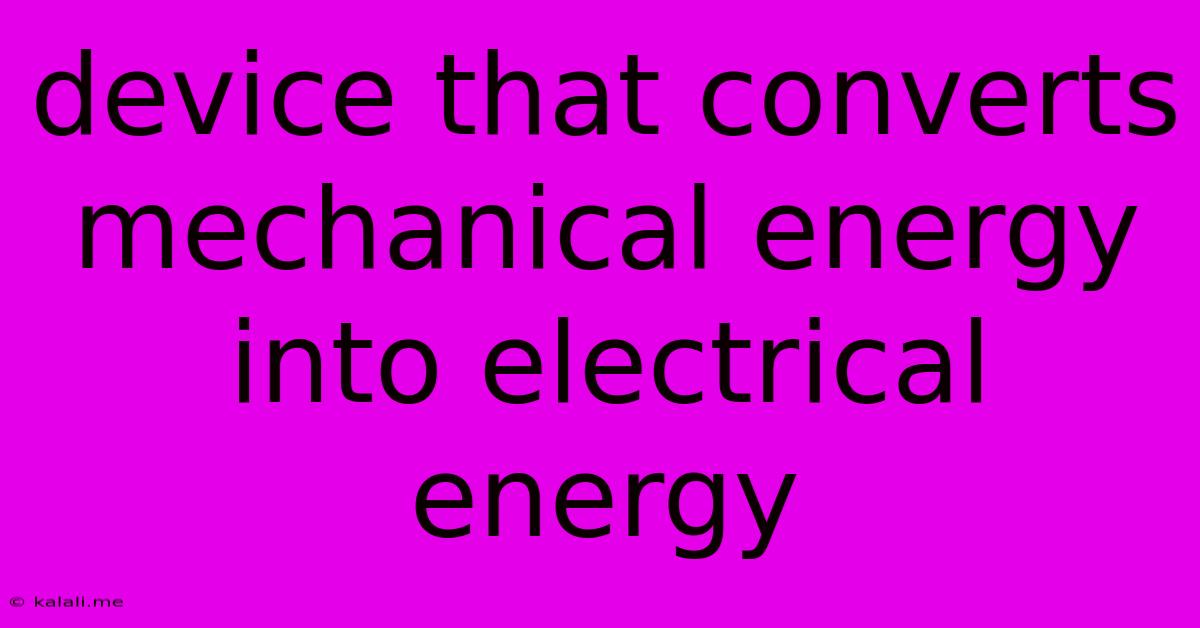Device That Converts Mechanical Energy Into Electrical Energy
Kalali
Jun 15, 2025 · 3 min read

Table of Contents
Devices that Convert Mechanical Energy into Electrical Energy: A Comprehensive Guide
Meta Description: This article explores various devices that convert mechanical energy into electrical energy, explaining their principles, applications, and advantages. Learn about generators, dynamos, piezoelectric devices, and more!
Mechanical energy, the energy of motion and position, is ubiquitous in our world. From the turning of a wheel to the flow of water, this energy is constantly being harnessed and transformed. One particularly useful transformation is converting mechanical energy into electrical energy, powering everything from our homes to our vehicles. This article delves into the fascinating world of devices that achieve this conversion, examining their principles, applications, and relative merits.
Types of Mechanical-to-Electrical Energy Converters
Several ingenious devices effectively convert mechanical energy into electrical energy. Let's explore some key examples:
1. Generators: These are perhaps the most common and widely used devices for this conversion. Generators operate on the principle of electromagnetic induction, discovered by Michael Faraday. When a conductor moves within a magnetic field, or conversely, a magnetic field moves across a conductor, a voltage is induced, resulting in an electric current. This is the fundamental principle behind all generators, whether they are small hand-cranked models or massive power station turbines. Generators come in various types, including:
- AC Generators (Alternators): These produce alternating current (AC), the type of electricity commonly used in homes and businesses.
- DC Generators (Dynamos): These generate direct current (DC), used in applications requiring a constant voltage, like battery charging.
2. Dynamos: While often used interchangeably with generators, dynamos specifically refer to direct current (DC) generators. Historically significant, dynamos played a crucial role in the early development of electrical technologies. They are still used in specific applications where DC power is needed directly.
3. Piezoelectric Devices: These devices utilize the piezoelectric effect, a phenomenon where certain materials generate an electric charge in response to applied mechanical stress or pressure. This effect is exploited in various applications, including:
- Piezoelectric Sensors: These devices detect pressure, vibration, or acceleration and convert them into electrical signals.
- Piezoelectric Generators: These harvest energy from mechanical vibrations, offering potential applications in energy harvesting from ambient sources.
4. Magnetohydrodynamic (MHD) Generators: These operate on a different principle, using a conducting fluid (usually a plasma) moving through a magnetic field to generate electricity. While still under development, MHD generators hold the potential for high-efficiency power generation, particularly for applications in space exploration and advanced power plants.
Applications of Mechanical-to-Electrical Energy Conversion
The applications of devices converting mechanical energy into electrical energy are vast and impactful:
- Power Generation: Power plants utilize large generators driven by steam turbines (powered by fossil fuels, nuclear reactions, or geothermal energy), hydroelectric turbines (using flowing water), and wind turbines (using wind energy) to generate electricity for widespread use.
- Automotive Industry: Alternators in vehicles convert mechanical energy from the engine to recharge the battery and power electrical components.
- Portable Power: Hand-cranked generators provide emergency power in situations where grid power is unavailable.
- Energy Harvesting: Piezoelectric generators are increasingly used in various applications, such as powering small electronic devices from ambient vibrations.
- Medical Devices: Certain medical implants utilize piezoelectric materials for energy harvesting or sensing.
Advantages and Considerations
Converting mechanical energy into electrical energy offers several advantages, including:
- Reliable Power Source: Generators provide a reliable source of electricity, especially in remote areas or during emergencies.
- Renewable Energy Integration: Hydroelectric and wind power plants harness renewable resources to generate electricity.
- Efficient Energy Transfer: Generators can efficiently convert mechanical energy into electrical energy, minimizing losses.
However, it's also important to consider:
- Environmental Impact: Fossil fuel-powered power plants contribute to air pollution and greenhouse gas emissions.
- Maintenance Requirements: Generators and other mechanical-to-electrical energy converters require regular maintenance to ensure optimal performance.
In conclusion, the ability to convert mechanical energy into electrical energy is a cornerstone of modern technology. The various devices discussed above showcase the ingenuity and diversity of approaches to achieving this crucial transformation. As technology advances, we can expect even more efficient and sustainable methods to harness mechanical energy and convert it into the electrical power that drives our world.
Latest Posts
Latest Posts
-
The Elements In Group 18 Are Called The
Jun 15, 2025
-
Least Common Multiple Of 20 And 18
Jun 15, 2025
-
Which Of The Following Is An Example Of New Media
Jun 15, 2025
-
According To Dalton Atoms Of Different Elements Will Be
Jun 15, 2025
-
Match The Words With Their Meanings Answer
Jun 15, 2025
Related Post
Thank you for visiting our website which covers about Device That Converts Mechanical Energy Into Electrical Energy . We hope the information provided has been useful to you. Feel free to contact us if you have any questions or need further assistance. See you next time and don't miss to bookmark.